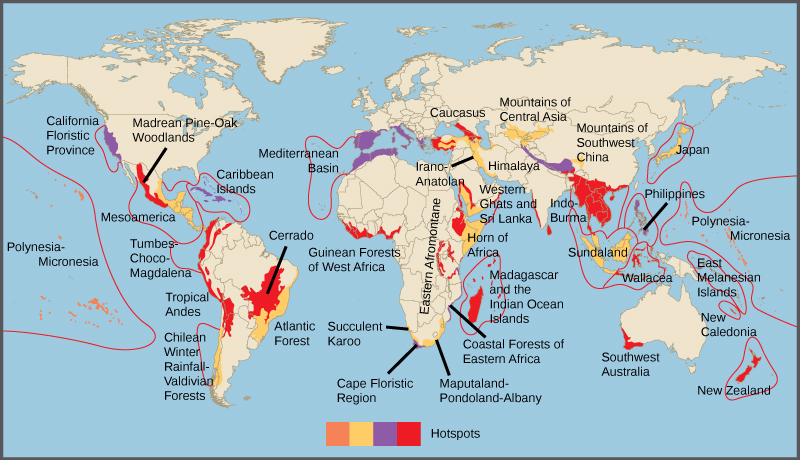
The concept of the hotspot was first introduced by:
A. Mayer
B. Simpson
C. Myers
D. David
Answer
577.5k+ views
Hint: He was a British ecologist.
Complete answer: Norman Myers was a British ecologist who published a seminal paper in 1988 identifying 10 tropical forest “hotspots”. They are large areas of forests that contain exceptional concentrations of plant endemism and that are experiencing very high rates of habitat loss.
1. Hotspots are home to endemic plants and animals. Endemism means that the organism is present nowhere else on earth and is limited to that specific niche.
2. Endemic animals/ plants are the most susceptible to endangerment and extinction.
These are also known as biodiversity hotspots. It currently accounts for 2.3% of the Earth's land surface. 3. Currently, there are 36 biodiversity hotspots existing in the world.
For an area to be recognized as a hotspot, it must meet the following two strict criteria.
4. It must contain at least 1,500 species of vascular plants found nowhere else on Earth (endemic species) and at least 70 percent of its primary native/ endemic vegetation.

India hosts 4 biodiversity hotspots:
1. The Himalayas.
2. The Western Ghats.
3. The Indo-Burma region.
4. The Sundaland (Includes the Nicobar group of Islands).
So, the correct answer is “Option A”.
Note: 1. In the western ghats, there are more than 6000 vascular plants belonging to more than 2500 genus. 3000 plants out of these are endemic. The region is also home to around 450 species of birds, 140 mammals, 260 reptiles, and 175 amphibians.
2. The Himalayan hotspot is a region comprising Bhutan, Northeast India, and Southern, Central, and Eastern Nepal. It has some of the tallest peaks in the world. There are about 163 endangered species in this region including one-horned rhinoceros, wild Asian water buffalo, and 45 mammals, 50 birds, 12 amphibians, 17 reptiles, 3 invertebrate, and 36 plant species.
Complete answer: Norman Myers was a British ecologist who published a seminal paper in 1988 identifying 10 tropical forest “hotspots”. They are large areas of forests that contain exceptional concentrations of plant endemism and that are experiencing very high rates of habitat loss.
1. Hotspots are home to endemic plants and animals. Endemism means that the organism is present nowhere else on earth and is limited to that specific niche.
2. Endemic animals/ plants are the most susceptible to endangerment and extinction.
These are also known as biodiversity hotspots. It currently accounts for 2.3% of the Earth's land surface. 3. Currently, there are 36 biodiversity hotspots existing in the world.
For an area to be recognized as a hotspot, it must meet the following two strict criteria.
4. It must contain at least 1,500 species of vascular plants found nowhere else on Earth (endemic species) and at least 70 percent of its primary native/ endemic vegetation.

India hosts 4 biodiversity hotspots:
1. The Himalayas.
2. The Western Ghats.
3. The Indo-Burma region.
4. The Sundaland (Includes the Nicobar group of Islands).
So, the correct answer is “Option A”.
Note: 1. In the western ghats, there are more than 6000 vascular plants belonging to more than 2500 genus. 3000 plants out of these are endemic. The region is also home to around 450 species of birds, 140 mammals, 260 reptiles, and 175 amphibians.
2. The Himalayan hotspot is a region comprising Bhutan, Northeast India, and Southern, Central, and Eastern Nepal. It has some of the tallest peaks in the world. There are about 163 endangered species in this region including one-horned rhinoceros, wild Asian water buffalo, and 45 mammals, 50 birds, 12 amphibians, 17 reptiles, 3 invertebrate, and 36 plant species.
Recently Updated Pages
The number of solutions in x in 02pi for which sqrt class 12 maths CBSE

Write any two methods of preparation of phenol Give class 12 chemistry CBSE

Differentiate between action potential and resting class 12 biology CBSE

Two plane mirrors arranged at right angles to each class 12 physics CBSE

Which of the following molecules is are chiral A I class 12 chemistry CBSE

Name different types of neurons and give one function class 12 biology CBSE

Trending doubts
Sketch the electric field lines in case of an electric class 12 physics CBSE

Explain the formation of energy bands in solids On class 12 physics CBSE

Mention any two factors on which the capacitance of class 12 physics CBSE

Drive an expression for the electric field due to an class 12 physics CBSE

Draw a ray diagram of compound microscope when the class 12 physics CBSE

a Draw Labelled diagram of Standard Hydrogen Electrode class 12 chemistry CBSE




